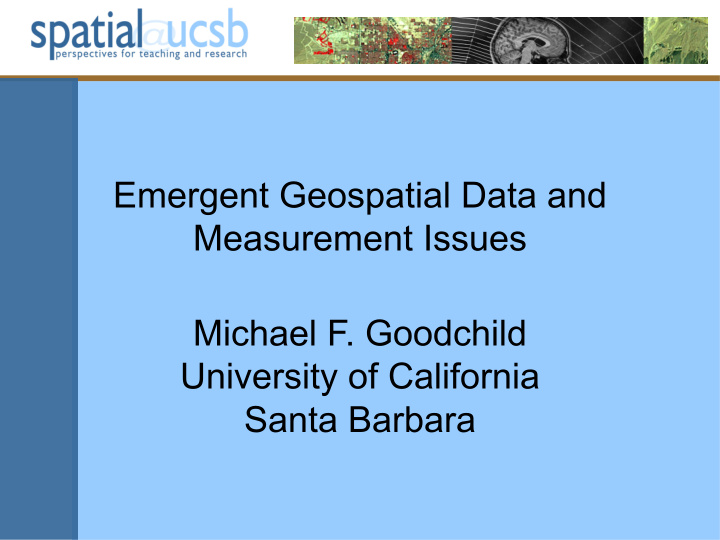



Emergent Geospatial Data and Measurement Issues Michael F. Goodchild University of California Santa Barbara
New data sources: VGI Volunteered and therefore free • Abundant • Timely • – time-critical community mapping Multidimensional • – if people can map anything, what do they choose to map? • graffiti, potholes, shortcuts, cemeteries No guarantees • – metadata, data quality – three approaches
http://www.directrelief.org/Flash/HaitiShipments/Index.html
Crandall et al. 2009. Mapping the world’s photos. http://www.cs.cornell.edu/~crandall/papers/mapping09www.pdf
Density of geo-located tweets in Los Angeles, Jan1 to Feb 25, 2011
The crowd solution Linus’s Law • – the more eyes to review, the more accurate – works for popular facts – in emergencies confidence is based on the number of identical reports Geographic facts may be obscure • – little-known areas of the world • or not so obscure – in emergencies a single report may be crucial
The social solution Who can be trusted? • A hierarchy of moderators and gate-keepers • – all volunteered facts referred up the hierarchy A social structure • – promotion based on track record – heavy, accurate contributors promoted – e.g., Wikipedia, OSM – top levels of Google MapMaker reserved for Google staff
The geographic solution How can we know if a purported geographic • fact is false? – because it violates the rules by which the geographic world is constructed – the syntactic rules – compare language rules, the sentence structure of English What are those rules? • – essential, fundamental geographic knowledge
Some sample rules Tobler’s First Law • – “…but nearby things are more similar than distant things” – horizontal context – a geographic fact should be consistent with its surroundings “All things are related…” • – vertical context – a geographic fact should be consistent with other things that are known about that location
Census issues Traditionally the primary source of data for • spatial demography The American Community Survey • – replacement for the Long Form – a Republican target – a rolling monthly sample • 1-year, 3-year, 5-year estimates – sacrificing spatial detail for temporal For spatial demography? • – good for coarse analysis of rapid change – poor for detailed analysis
Administrative data Tax returns, social programs, local • government records In some countries a replacement for the • traditional census Little progress in the US • – lack of coordination between agencies and levels of government
Private-sector data Google, Facebook, etc. • Vast amounts of social data of potential • relevance to social demography – no regular sampling, no quality control – “soft” data – but soft data has value in science • exploratory research • hypothesis generation In-house research • – Facebook’s analyses of network linkages – 4.74 degrees ( New York Times 21 Nov 2011)
Privacy and confidentiality Many data types of great interest to spatial • demography are off limits to researchers – tracks of individuals – administrative records – detailed census records The Census Data Center solution • – requires physical presence The virtual Census Data Center • – a firewall preventing unacceptable queries – many unresolved technical issues
Reporting-zone geometry Data must be aggregated to protect • confidentiality Reporting zones change through time • Reporting zones may not meet the needs of • specific projects Adopting standard reporting zones leads to • distortion – e.g., defining an individual’s neighborhood by the containing census tract
Possible approaches Re-aggregation of smaller zones • Make available all reporting-zone geometries • – NHGIS (National Historic GIS) • all historic Census geometries – SABINS • all school catchment areas by grade Areal interpolation •
1 target zone 4 source zones 15% of B B A C 10% of A D 5% of C 50% of D PopTARGET = 0.10 PopA + 0.15 PopB + 0.05 PopC + 0.50 PopD
Concluding points A very dynamic area • – many new data sources – powerful new technologies – the modern era of taxpayer-financed, rigorously controlled data sets is clearly losing ground – a post-modern era of disparate data sets is emerging – we do not yet understand the implications • quality control, synthesis • what new kinds of social science are enabled – some important issues for discussion
Recommend
More recommend